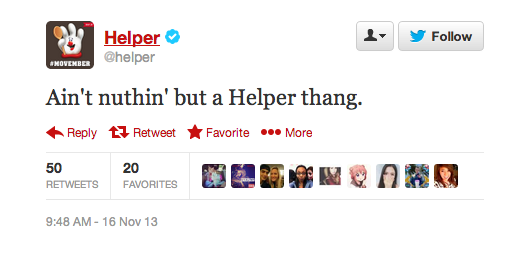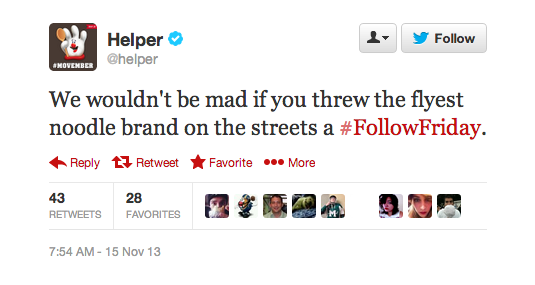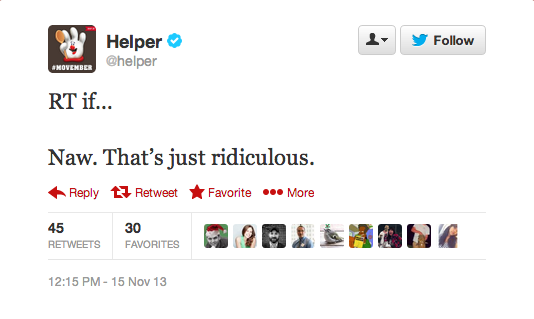
When you think of Hamburger Helper, which has been around since 1971, you probably don’t think of the Internet. But the General Mills brand of pasta-in-a-box meals is trying to change that with its revamped Twitter strategy which, at least according to its Twitter bio, entails “trolling lame dinners.”
Hamburger Helper only joined Facebook in November 2012. It created its Twitter account, @helper, a little later after realizing a core part of its audience – young dudes – wasn’t really on Facebook as much.
“At first Facebook was our focus — that’s more mainstream and more family-oriented, it’s the moms and dads,” explained Eric Johnson, digital marketing manager at General Mills. “Millennials and young guy audiences that we have aren’t as much on Facebook, so Twitter was the right place to do that that engagement.”
It’s really only been over the past four weeks that the brand’s digital team has been focusing on perfecting its Twitter game. After conducting immersive consumer research and creating offline experiences, like Hamburger Helper food trucks, the brand felt it had a better understanding of its young, male audience.
Ad position: web_incontent_pos1
This, in turn, helped shape its new Twitter voice into one that has a playful, millennial tone and (occasionally painful) cheeky hip-hop vernacular, like this:

And this:

As Johnson sees it, the strategy is about using Lefty, Hamburger Helper’s brand mascot, in a self-aware, funny way that provides entertainment and isn’t forced – all of which is a lot easier said than done as a brand. Johnson and his team do this by having daily meetings and monitoring online conversations to see what cultural happenings and topics make sense for the brand to chime in about (like this Miley Cyrus reference). Perhaps most importantly, though, Johnson and his team of three are aware that there is a time not to chime in.
“We want to find conversations that we can introduce something about dinner that’s fun without forcing ourselves into the conversation, because that’s really lame,” said Johnson. “There are some brands that do that and you cringe, and we don’t want to do that.”
As for avoiding those cringeworthy moments, Johnson and his team don’t have a hard and fast rules. It’s more of a learning process that involves “a feeling and intuition,” he said. That intuition pays off in certain tweets, like this slyly clever request for a retweet:

So far, it seems like the strategy is working. In the month since the brand started its Twitter makeover, its following has more than tripled. Today @helper has upwards of 6,900 followers, and Johnson hopes the growth will continue – as long as it’s not at the expense of their street cred.
Ad position: web_incontent_pos2
“Obviously if a million people are having Hamburger Helper every night, then I’d love to see a million more,” he said. “But if we force a product message and get too corporate the whole thing falls apart.”
More in Marketing

In the marketing world, anime is following in the footsteps of gaming
As marketers look to take advantage of anime’s entry into the zeitgeist, they might be wise to observe the parallels between the evolution of anime as a marketing channel and the ways brands have learned to better leverage gaming in recent years.

With the introduction of video ads and e-commerce, Roblox looks to attain platform status
Roblox is expanding into more areas than just ads in 2024. Much like platforms such as Amazon and Facebook have transcended their origins to evolve from their origins as online marketplaces and social media channels, Roblox is in the midst of a transformation into a platform for all elements of users’ virtual lives.

PepsiCo wants to remain a ‘driver of culture’ as it turns to influencers and activations amid rebrand
The soda-maker says it can translate cultural relevance into sales volume.
Ad position: web_bfu